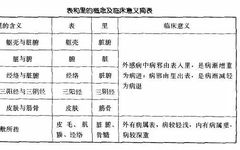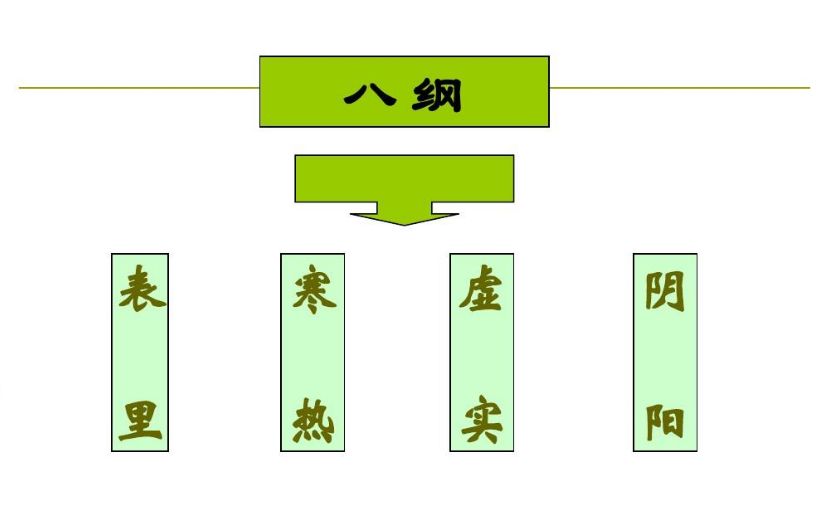
The Eight Principles (Ba Gang) of Diagnosis is a fundamental method of diagnosis. It utilizes the eight principles of Yin-Yang, Exterior-Interior, Cold-Heat, and Deficiency-Excess to analyze and summarize disease patterns, providing a basis for treatment. The Exterior-Interior principle differentiates the depth of the disease location; Cold-Heat distinguishes the nature of the disease; Deficiency-Excess identifies the strength of the pathogenic factors; and Yin-Yang serves as the overarching principle governing the other six. The Exterior, Heat, and Excess belong to Yang, while the Interior, Cold, and Deficiency belong to Yin. The four pairs of contradictions in the Eight Principles are relative, interconnected, and can transform into one another. The complex clinical syndromes can all be analyzed and summarized using this fundamental method. The Eight Principles of Diagnosis is the overarching principle of various diagnostic methods in TCM.
Diagnosis refers to the process of analyzing and identifying the symptoms of a disease, which is the main process and method for understanding and diagnosing diseases. To diagnose means to recognize and differentiate, which involves analysis. The term “syndrome” refers to the comprehensive manifestation of the disordered relationship between the body and the environment, as well as between the organs, meridians, Qi, blood, and body fluids under the influence of pathogenic factors. Therefore, clarifying a specific syndrome summarizes the pathological conditions of the disease’s development stage, including the causes, locations, the strength of the struggle between pathogenic and righteous Qi, and the imbalance of Yin and Yang.
The process of diagnosis is based on theories of the organs, meridians, Qi, blood, body fluids, and pathogenic factors, and involves the comprehensive analysis, summarization, reasoning, judgment, and clarification of the internal relationships among the symptoms and signs collected through the four diagnostic methods: observation, listening, inquiry, and palpation, thereby understanding the disease and making an accurate diagnosis.
Diagnosis and Treatment are two crucial interrelated and inseparable aspects of TCM theory, methods, formulas, and medicines in clinical practice. Diagnosis is the understanding of the disease, while treatment refers to the corresponding therapeutic measures and methods taken based on the diagnosed syndrome. Diagnosis is the premise and basis for treatment, while treatment is the objective of diagnosis and an objective standard for verifying the correctness of the diagnosis.
“Symptom” refers to an individual symptom, which is recognized similarly in both Chinese and Western medicine, such as headache, fever, cough, palpitations, nausea, etc.
“Disease” refers to the name of the disease. Among the disease names in TCM, only a few correspond to Western medical terms, such as measles, diphtheria, tetanus, asthma, dysentery, and heat stroke, while most terms differ. Due to the differences in theoretical systems, the understanding of diseases varies between TCM and Western medicine. Western medicine’s understanding of diseases is based on human anatomy and pathophysiology, with clinical diagnosis relying on the patient’s subjective symptoms, physical examination, and laboratory tests. TCM, however, views diseases as the result of imbalances in Yin and Yang, with clinical diagnosis primarily based on the patient’s symptoms and signs (such as tongue and pulse diagnosis), without necessarily determining the disease name but rather clarifying the “syndrome”.
“Syndrome” is a shorthand for evidence and symptoms, which is not merely a collection of symptoms or subjective feelings, but a group of syndromes. It is TCM’s way of diagnosing diseases. A “syndrome” is a set of specific clinical manifestations (symptoms, signs, etc.) that encompasses the causes, affected areas, nature of the disease, and the comparative strength of the pathogenic and righteous Qi. The concept of “syndrome” is derived from analyzing symptoms and signs, summarizing them into a concept that better explains the essence of the disease.
TCM diagnosis has been formed through long-term clinical practice, with various methods including the Eight Principles, etiology-based diagnosis, Qi and blood diagnosis, organ diagnosis, Wei-Qi-Ying-Blood diagnosis, Sanjiao diagnosis, and Six Meridians diagnosis. Among these, the Eight Principles diagnosis is the overarching principle.
The Eight Principles diagnosis is based on the materials obtained from the four diagnostic methods, conducting a comprehensive analysis to explore the nature of the disease, the depth of the lesions, the severity of the condition, the strength of the body’s response, and the comparative strength of the pathogenic and righteous Qi, summarizing them into eight categories of syndromes: Yin, Yang, Exterior, Interior, Cold, Heat, Deficiency, and Excess. This is a fundamental method of TCM diagnosis, encompassing various diagnostic methods and summarizing their commonalities, playing a role in simplifying complex conditions and providing a clear framework for diagnosis.
Although the manifestations of diseases are extremely complex, they can generally be categorized into the Eight Principles. The overall categories of diseases include Yin syndromes and Yang syndromes; the depth of the disease can be classified as Exterior or Interior; the imbalance of Yin and Yang can lead to Heat syndromes (Yang excess or Yin deficiency) or Cold syndromes (Yin excess or Yang deficiency); the strength of the pathogenic and righteous Qi can be classified as Excess syndromes (when pathogenic Qi is strong) or Deficiency syndromes (when righteous Qi is weak). Therefore, the Eight Principles diagnosis analyzes the ever-changing diseases according to the simple dichotomies of Exterior and Interior, Cold and Heat, Deficiency and Excess, Yin and Yang, revealing the contradictions in the disease process, thus capturing the essence of whether the disease is located in the Exterior or Interior, whether it is Cold or Heat, whether it is Deficient or Excess, and whether it belongs to Yin or Yang. This is the fundamental spirit of the Eight Principles.
-
The Eight Principles:(Yin syndrome, Yang syndrome, Exterior syndrome, Interior syndrome, Deficiency syndrome, Excess syndrome, Cold syndrome, Heat syndrome)
1. Exterior and Interior
The Exterior and Interior principles indicate the depth of the disease location and the severity of the condition. Generally speaking, the skin, hair, and superficial meridians belong to the Exterior; the organs, blood vessels, bone marrow, and internal meridians belong to the Interior. Exterior syndrome indicates a superficial disease located in the skin, with a mild condition; Interior syndrome indicates a deeper disease located in the organs, with a more severe condition.
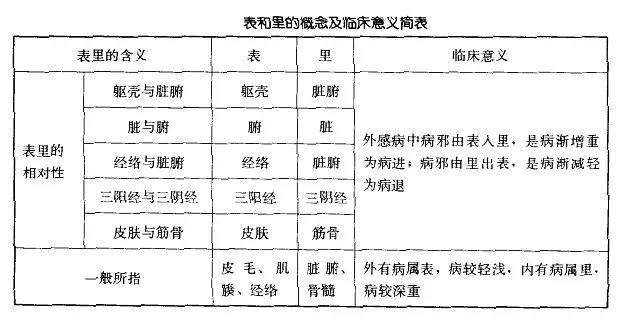
(1) Exterior Syndrome
Exterior syndrome is characterized by a superficial disease located in the skin. Generally, it occurs when the six external pathogenic factors invade the body through the skin and nose, leading to a series of symptoms where the righteous Qi (Wei Qi) resists the pathogenic factors, often seen in the initial stage of external diseases. Exterior syndrome is characterized by a rapid onset, short duration, superficial location, and mild condition. It is commonly seen in the early stages of external heat diseases, such as upper respiratory infections, acute infectious diseases, and other initial stages of infectious diseases.
Main symptoms: fever and chills (or aversion to wind), headache, thin white tongue coating, and floating pulse are the basic symptoms, often accompanied by symptoms such as muscle aches in the limbs and body, nasal congestion, and cough.
Due to the differences in the nature of the external pathogenic factors (Cold or Heat), and the varying strength of the body’s ability to resist these factors, Exterior syndrome can be further divided into Exterior Cold, Exterior Heat, Exterior Deficiency, and Exterior Excess syndromes.
1. Exterior Cold Syndrome
Main symptoms: significant aversion to cold, mild fever, pronounced pain in the head and body, no sweating, clear nasal discharge, and no thirst. The tongue is pale red, with a thin white and moist coating, and the pulse is floating and tight.
Pathogenesis: Cold pathogenic factors are constrained in the skin or muscle layer, leading to a struggle between the righteous and pathogenic Qi, hence the aversion to cold and fever. The invasion of pathogenic Qi into the superficial meridians causes stagnation in the flow of Wei Qi and blood, resulting in pain in the head, body, and limbs. The pulse is floating due to the struggle between the righteous and pathogenic Qi at the surface.
Treatment principle: Release the exterior with warm acrid herbs.
Common formula: Ma Huang Tang (Ephedra Decoction).
2. Exterior Heat Syndrome
Main symptoms: significant fever, mild aversion to cold, headache, sore throat, sweating, and yellow nasal discharge, with thirst. The tongue is slightly red, with a thin white coating that is not moist, and the pulse is floating and rapid.
Pathogenesis: The struggle between the righteous and pathogenic Qi at the surface leads to fever and aversion to cold. Heat pathogenic factors invade the Wei level, causing sweating. Heat damages body fluids, leading to thirst. The presence of heat at the surface results in a floating and rapid pulse.
Treatment principle: Release the exterior with cool acrid herbs.
Common formula: Yin Qiao San (Honeysuckle and Forsythia Powder).
3. Exterior Deficiency Syndrome
Main symptoms: Exterior syndrome with aversion to wind, sweating. The tongue is pale, with a thin white coating, and the pulse is floating and weak.
Pathogenesis: The patient has a weak constitution, and the Wei Yang is not firm, leading to aversion to wind and sweating, with a floating and weak pulse.
Treatment principle: Harmonize the Ying and Wei, and release the exterior.
Common formula: Gui Zhi Tang (Cinnamon Twig Decoction).
4. Exterior Excess Syndrome
Main symptoms: fever, aversion to cold, body aches, no sweating. The tongue is pale red, with a thin white coating, and the pulse is floating and strong.
Pathogenesis: The pathogenic factors are strong, and the righteous Qi is not weak; the pathogenic factors constrain the skin, and the righteous Qi resists the pathogenic factors, leading to fever and aversion to cold without sweating, with a floating and strong pulse.
Treatment principle: Release the exterior with warm acrid herbs.
Common formula: Ma Huang Tang (Ephedra Decoction).
Distinguishing between Exterior Cold and Exterior Heat syndromes is based on the severity of aversion to cold and fever, as well as tongue and pulse characteristics. Exterior Cold syndrome presents with significant aversion to cold and mild fever, while Exterior Heat syndrome presents with significant fever and mild aversion to cold. In addition, the tongue coating and pulse characteristics differ: Exterior Cold syndrome has a thin white and moist coating with a floating and tight pulse, while Exterior Heat syndrome has a thin white coating that is not moist with a floating and rapid pulse. Furthermore, the external pathogenic factors of wind and cold can transform into heat, leading to a transition from Exterior Cold syndrome to Exterior Heat syndrome. Once the external pathogenic factors invade the interior, they can easily transform into interior heat, resulting in a transition from Exterior Cold (or Heat) syndrome to Interior Heat syndrome.
Distinguishing between Exterior Deficiency and Exterior Excess syndromes involves considering the patient’s constitution, with the presence of sweating indicating deficiency and the absence of sweating indicating excess. Exterior Excess syndrome is often seen in younger, robust individuals, while Exterior Deficiency syndrome is more common in older, weaker, or chronically ill patients.
(2) Interior Syndrome
Interior syndrome, in contrast to Exterior syndrome, refers to conditions that are deeper within the body (organs, Qi, blood, bone marrow, etc.).
The causes of Interior syndrome can generally be classified into three categories: first, the progression of Exterior syndrome, where the exterior pathogenic factors do not resolve and penetrate into the interior, affecting the organs; second, direct invasion of external pathogenic factors into the internal organs, such as abdominal cold or overconsumption of cold foods leading to Interior Cold syndrome; third, internal injuries from emotional stress, overwork, or dietary factors that directly impair organ function, leading to symptoms such as dizziness and pain in the liver area, palpitations and shortness of breath in heart disease, cough and wheezing in lung disease, abdominal distension and diarrhea in spleen disease, and low back pain and urinary retention in kidney disease. Therefore, the clinical manifestations of Interior syndrome are complex, and all symptoms that are not classified as Exterior syndrome fall under Interior syndrome. In cases of external diseases, Interior syndrome should be differentiated based on etiology, Wei-Qi-Ying-Blood, while in cases of internal injuries, organ diagnosis should be the primary focus. Interior syndrome can be further classified into Interior Cold, Interior Heat, Interior Deficiency, and Interior Excess (discussed under Cold-Heat and Deficiency-Excess diagnosis).
Distinguishing between Exterior and Interior syndromes is primarily based on the patient’s history, the nature of the disease, and changes in tongue coating and pulse. Generally, new or acute diseases with a short duration are more likely to be classified as Exterior syndromes, while chronic or long-standing diseases are often classified as Interior syndromes. Fever with aversion to cold indicates an Exterior syndrome; fever without aversion to cold or only cold without fever indicates an Interior syndrome. The tongue coating in Exterior syndrome often shows no changes or may only show redness at the edges and tip, while Interior syndrome often presents with abnormal tongue coatings. A floating pulse indicates an Exterior syndrome, while a deep pulse indicates an Interior syndrome.
(3) Half Exterior Half Interior Syndrome
This syndrome occurs when the pathogenic factors are neither fully in the Exterior nor have they fully entered the Interior, resulting in symptoms that are neither typical of Exterior nor Interior syndromes.
Main symptoms: alternating chills and fever, chest and hypochondriac fullness, bitter mouth and dry throat, irritability, nausea, loss of appetite, and dizziness. The tongue tip is red, with a mixed yellow and white coating, and the pulse is wiry.
Pathogenesis: The struggle between the righteous and pathogenic Qi occurs in the half Exterior half Interior space, leading to alternating chills and fever. The pathogenic factors invade the half Exterior half Interior space, affecting the gallbladder meridian, resulting in chest and hypochondriac fullness, and heat in the gallbladder leading to disharmony between the liver and stomach, causing irritability, dizziness, nausea, and loss of appetite.
Treatment principle: Harmonize and resolve the Exterior and Interior.
Common formula: Xiao Chai Hu Tang (Minor Bupleurum Decoction).
(4) Simultaneous Exterior and Interior Disease (Mixed Exterior and Interior)
This refers to the simultaneous presence of both Exterior and Interior syndromes at the same time, which can occur in three common scenarios: first, the initial onset of the disease may present with both Exterior and Interior symptoms; second, during the course of the disease, there may initially be only Exterior symptoms, but as the pathogenic factors penetrate into the Interior, Interior symptoms appear while Exterior symptoms remain unresolved, which is also referred to as simultaneous Exterior and Interior disease; third, if the original disease has not resolved, it may also present with mixed symptoms, such as having an internal injury while also being affected by an external pathogenic factor, or having an external condition that has led to dietary injury, which also falls under simultaneous Exterior and Interior disease. The treatment principle is to resolve both the Exterior and Interior simultaneously.
2. Cold and Heat
Cold and Heat are the two principles used to differentiate the nature of diseases, summarizing the two categories of the body’s Yin and Yang. Generally speaking, Cold syndromes are manifestations of insufficient Yang Qi or the invasion of Cold pathogenic factors, while Heat syndromes are manifestations of excessive Yang Qi or the invasion of Heat pathogenic factors. The saying goes, “Excess Yang leads to Heat, Excess Yin leads to Cold; Deficient Yang leads to Cold, Deficient Yin leads to Heat.” Differentiating between Cold and Heat is the basis for using warming or cooling herbs in treatment, as the principle states, “Cold is treated with Heat, and Heat is treated with Cold.”
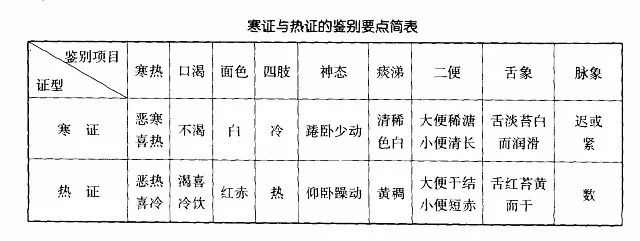
(1) Cold Syndrome
Cold syndrome is characterized by the invasion of Yin Cold pathogenic factors (such as Cold or Dampness) or the deficiency of Yang leading to an excess of Yin, resulting in weakened organ function and reduced activity. It can be divided into Exterior Cold syndrome and Interior Cold syndrome, with the former already discussed under Exterior syndrome, while the latter refers to Interior Cold syndrome.
Main symptoms: aversion to cold, cold limbs, no thirst or preference for warm drinks, pale complexion, cough with white phlegm, abdominal pain relieved by warmth, loose stools, and clear, profuse urination. The tongue is pale, with a white coating, and the pulse is deep and slow.
Pathogenesis: Yang deficiency leads to an excess of Yin, causing the patient to feel cold. Cold in the spleen and stomach leads to abdominal pain relieved by warmth, and the pulse is deep and slow due to weak Yang Qi.
Treatment principle: Warm the middle and dispel Cold.
Common formula: Fu Zi Li Zhong Tang (Aconite Decoction to Regulate the Middle).
(2) Heat Syndrome
Heat syndrome is characterized by the invasion of Yang Heat pathogenic factors (such as Wind, Heat, or Fire) or the excess of Yang leading to Yin deficiency, resulting in excessive organ function and increased activity. It can be divided into Exterior Heat syndrome and Interior Heat syndrome, with the former already discussed under Exterior syndrome, while the latter refers to Interior Heat syndrome.
Main symptoms: fever, no aversion to cold, irritability, thirst with a preference for cold drinks, red face and eyes, cough with yellow, thick phlegm, abdominal pain relieved by coolness, constipation, and dark, scanty urination. The tongue is red, with a yellow coating, and the pulse is rapid.
Pathogenesis: Excess Yang leads to fever and a preference for coolness, while Heat damages body fluids, leading to thirst. The presence of Heat leads to a rapid pulse.
Treatment principle: Clear Heat.
Common formula: Bai Hu Tang (White Tiger Decoction).
(3) Excess Heat and Deficient Heat
Excess Heat syndrome, caused by the invasion of Heat pathogenic factors, and Deficient Heat syndrome, caused by Yin deficiency or excessive organ function, present different clinical manifestations and treatment principles.
Excess Heat syndrome has a rapid onset and short duration, with high fever, aversion to heat, profuse sweating, delirium, and even mania. It is characterized by thirst and a preference for drinking, cough with yellow, thick phlegm, constipation, and dark, scanty urination. The tongue is red, with a thick yellow coating, and the pulse is rapid and forceful. This syndrome is often caused by Heat pathogenic factors (such as infections) and is treated by clearing Heat and draining Fire.
Deficient Heat syndrome has a slow onset and long duration, with low-grade fever, tidal fever, night sweats, irritability, and insomnia. The patient may have dry mouth but drinks little, with scanty, sticky phlegm, or phlegm with blood streaks. The stool is small in volume, and the urine is yellow and scanty. The cheeks may be flushed, the tongue is red with little or no coating, and the pulse is thin and rapid. This syndrome is often caused by excessive organ function and is treated by nourishing Yin and clearing Heat.
(4) True Cold and False Heat
In critical stages of disease development, one may observe phenomena such as “true Cold appearing as Heat” and “true Heat appearing as Cold.” Clinically, a condition that is essentially Heat but presents with Cold symptoms is termed “true Heat false Cold,” while a condition that is essentially Cold but presents with Heat symptoms is termed “true Cold false Heat.” This situation often indicates a severe disease state. If the essence is not grasped, one may be misled by the false appearance, leading to misdiagnosis and mistreatment.
1. “True Cold false Heat”: For example, patients with chronic wasting diseases often present with fever, flushed cheeks, restlessness, a black tongue coating, and a floating pulse. On the surface, it appears to have Heat symptoms, but the patient prefers warmth, appears lethargic and apathetic, curls up while lying down, has a pale tongue, a black and moist coating, and a pulse that is floating but weak. This indicates that Yin is excessive internally, while Yang is constrained externally, and the essence is still Cold, hence termed “true Cold false Heat.” Treatment should focus on warming the interior and restoring Yang, guiding the fire back to the source.
2. “True Heat false Cold”: This refers to a condition where true Heat is present internally but appears as false Cold externally. For instance, in severe cases of heat-related diseases, one may observe a patient who appears indifferent, drowsy, and reluctant to speak, with cold hands and feet, a deep and thin pulse, which superficially resembles Cold syndrome. However, there are signs of heat in the mouth and nose, burning sensations in the chest and abdomen, thirst with a preference for cold drinks, constipation, and dark, scanty urination. The tongue is red, with a yellow and dry coating, and the pulse, although deep and thin, is rapid and forceful. This indicates that internal Yang Heat is constrained and cannot express outwardly, and the essence is Heat, hence termed “true Heat false Cold.” Treatment should focus on clearing internal Heat and promoting Yang Qi.
In general, the manifestations of Cold and Heat are superficial and represent a false appearance; the internal Cold and Heat represent the essence of the condition.
When distinguishing between Cold and Heat syndromes, one should not rely solely on a single symptom or sign but should observe the overall presentation of the disease, especially the aspects of Cold-Heat, thirst or lack of thirst, complexion, temperature of the limbs, urination, stool, tongue appearance, and pulse characteristics. For instance, aversion to cold and preference for warmth indicates Cold, while fever and preference for coolness indicate Heat; lack of thirst indicates Cold, while thirst with a preference for drinking indicates Heat; a red complexion indicates Heat; cold hands and feet often indicate Cold, while warm limbs indicate Heat; clear, profuse urination and loose stools indicate Cold, while dark, scanty urination and constipation indicate Heat; a pale tongue with a white coating indicates Cold, while a red tongue with a yellow coating indicates Heat, etc. From the comparison of Cold and Heat syndromes, it can be seen that Cold syndromes are associated with excess Yin and often occur alongside Yang deficiency, while Heat syndromes are associated with excess Yang and often present with signs of Yin deficiency.
3. Deficiency and Excess
Deficiency and Excess are the two principles used to differentiate the strength of the body’s righteous Qi and the severity of the pathogenic factors. Generally, Deficiency refers to insufficient righteous Qi, and Deficiency syndromes are manifestations of this insufficiency, while Excess refers to an overabundance of pathogenic factors, and Excess syndromes are manifestations of this overabundance. The Suwen states, “When the pathogenic factors are strong, it is Excess; when the essence is depleted, it is Deficiency.” From the perspective of the comparative strength of the righteous and pathogenic Qi, Deficiency syndromes indicate insufficient righteous Qi, while the pathogenic factors are not strong; Excess syndromes indicate strong pathogenic factors, but the righteous Qi has not yet declined, representing a stage of intense struggle between the righteous and pathogenic Qi. Differentiating between Deficiency and Excess is the basis for determining whether to tonify the righteous Qi (nourish Deficiency) or drain the pathogenic factors (reduce Excess), as the principle states, “Nourish the Deficient, drain the Excess.”
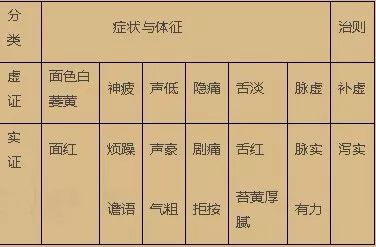
(1) Deficiency Syndrome
Deficiency syndromes arise from various causes, including weak constitution (either congenital or acquired), prolonged illness damaging the righteous Qi, loss of blood, loss of essence, excessive sweating, or invasion of external pathogenic factors that damage the righteous Qi.
Main symptoms: pale or sallow complexion, lethargy, fatigue, palpitations, shortness of breath, cold limbs, or five-center heat, spontaneous sweating, night sweats, loose stools, frequent urination, pale tongue with little or no coating, and weak pulse.
Clinically, Deficiency syndromes can be categorized into Qi Deficiency, Blood Deficiency, Yin Deficiency, and Yang Deficiency, based on the insufficiency of Qi, blood, Yin, or Yang, respectively. The Deficiency syndromes of the organs (such as Lung Qi Deficiency, Heart Blood Deficiency, Liver Yin Deficiency, Spleen Qi Deficiency, Kidney Yang Deficiency, etc.) will be discussed in the context of organ diagnosis.
The common symptoms of Qi Deficiency and Yang Deficiency include: pale or sallow complexion, lethargy, fatigue, low voice, spontaneous sweating, and reduced appetite. The tongue is pale and swollen, and the pulse is weak. The difference is that Qi Deficiency presents with shortness of breath and fatigue upon exertion, while Yang Deficiency presents with aversion to cold, cold limbs, clear urination, and loose stools. The treatment principle is to tonify Qi, commonly using Si Jun Zi Tang (Four Gentlemen Decoction) for Qi Deficiency and Shen Qi Wan (Kidney Qi Pill) or Ren Shen Rong Wan (Ginseng and Deer Antler Pill) for Yang Deficiency.
The common symptoms of Blood Deficiency and Yin Deficiency include: emaciation, dizziness, blurred vision, insomnia, palpitations, and thin pulse. The difference is that Blood Deficiency presents with a pale, sallow complexion, numbness in the hands and feet, pale lips and nails, a pale tongue, and a weak pulse. The treatment principle is to nourish blood, commonly using Si Wu Tang (Four Substance Decoction) for Blood Deficiency and Liu Wei Di Huang Wan (Six Flavor Rehmannia Pill) for Yin Deficiency.
From the above, it can be seen that Qi Deficiency and Yang Deficiency are both manifestations of insufficient Yang Qi, hence their clinical presentations are similar, both showing pale complexion, fatigue, spontaneous sweating, etc. However, they also have distinctions: Qi Deficiency is characterized by weakness without “Cold symptoms,” while Yang Deficiency is characterized by weakness with “Cold symptoms”—aversion to cold, cold limbs, and a slow pulse. Blood Deficiency and Yin Deficiency are both manifestations of insufficient Yin fluids, hence their clinical presentations are similar, both showing emaciation, dizziness, palpitations, insomnia, etc. However, they also have distinctions: Blood Deficiency is characterized by weakness without “Heat symptoms,” while Yin Deficiency is characterized by Yin fluid deficiency leading to Yang excess, hence presenting with “Heat symptoms”—low-grade fever, irritability, dry mouth, etc.
(2) Excess Syndrome
Excess syndromes arise from a robust constitution of the patient, where external pathogenic factors invade and cause acute illness, or from dysfunction of the organs leading to the accumulation of pathological products such as Qi stagnation, blood stasis, phlegm-dampness, parasites, or food stagnation.
Clinical manifestations vary based on the nature of the pathogenic factors and the organs affected, characterized by strong pathogenic Qi and weak righteous Qi, with intense struggle between the two. Common symptoms include high fever, flushed face, irritability, delirium, loud voice, abdominal distension and pain that resists pressure, excessive phlegm, constipation, scanty urination, or the presence of blood stasis, swelling, water retention, food stagnation, or parasites, with a thick and greasy tongue coating and a strong pulse.
Treatment principle: The main method for treating Excess syndromes is to drain the pathogenic factors, as the principle states, “Excess should be drained.” However, different methods of draining, such as clearing Heat, promoting bowel movements, draining water, dispelling phlegm, regulating Qi, invigorating blood, and eliminating parasites, will be discussed in relevant sections.
Distinguishing between Deficiency and Excess syndromes can be considered from the following aspects: regarding the time of onset, new or acute diseases or those with a short duration are often classified as Excess syndromes, while chronic or long-standing diseases are often classified as Deficiency syndromes; regarding the etiology, external pathogenic factors often lead to Excess syndromes, while internal injuries often lead to Deficiency syndromes; regarding the constitution, younger and stronger individuals are more likely to present with Excess syndromes, while older and weaker individuals are more likely to present with Deficiency syndromes; regarding clinical symptoms and signs, the following distinctions can be made:
Deficiency syndrome: pale, sallow, or lackluster complexion, fatigue, low voice, hidden pain that is relieved by pressure, pale tongue with a white coating or little coating, weak pulse. Treatment principle: tonify Deficiency.
Excess syndrome: flushed face, irritability, delirium, loud voice, severe pain that resists pressure, red tongue with a thick yellow coating, strong pulse. Treatment principle: drain Excess.
4. Yin and Yang
Yin and Yang are the two principles used to differentiate the nature of diseases, serving as the overarching principle of the Eight Principles, summarizing the Exterior-Interior, Cold-Heat, and Deficiency-Excess categories. The “Classifications of Yin and Yang” states, “In human diseases, there must be a basis, either rooted in Yin or in Yang. Although the manifestations of diseases are numerous, their essence is one,” indicating that although the symptoms may be complex and varied, they ultimately fall into the two categories of Yin and Yang. Therefore, the key to diagnosing diseases is to first determine whether they belong to Yin or Yang. Generally, Exterior, Excess, and Heat syndromes belong to Yang, while Interior, Deficiency, and Cold syndromes belong to Yin. Clinically, Yin syndromes often refer to Interior Deficiency Cold syndromes, while Yang syndromes often refer to Interior Excess Heat syndromes.
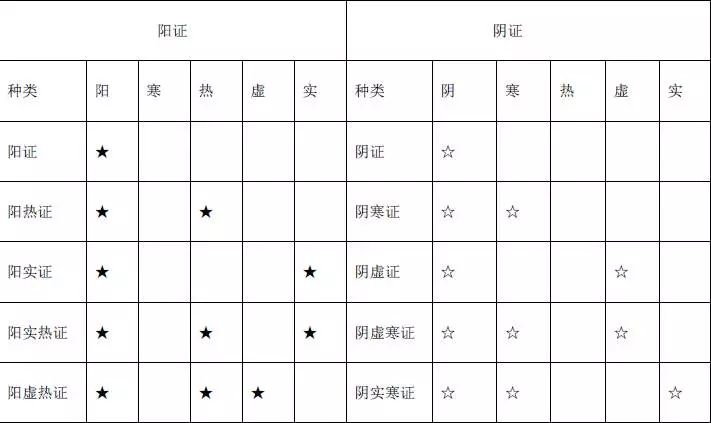
(1) Yin Syndrome
Yin syndrome is characterized by a deficiency of Yang Qi and an excess of Yin. Generally, Yin syndromes present with Cold symptoms, such as aversion to cold, absence of fever, cold limbs, lethargy, and a slow or weak pulse. This condition arises from the dysfunction of the organs, leading to a weakened response of the body, often seen in older or chronically ill patients, presenting a picture of deficiency and Cold.
(2) Yang Syndrome
Yang syndrome is characterized by an excess of Yang Qi and the preservation of righteous Qi. Generally, Yang syndromes present with Heat symptoms, such as fever, aversion to heat, warm limbs, irritability, thirst, and a rapid pulse. This condition arises from the hyperfunction of the organs, often seen in robust individuals, presenting a picture of excess and Heat.
(3) Loss of Yin and Loss of Yang
Loss of Yin and Loss of Yang are two dangerous syndromes that can occur during the disease process, often seen in cases of high fever, profuse sweating, severe vomiting and diarrhea, or excessive blood loss, leading to rapid loss of Yin fluids or Yang Qi, commonly seen in shock patients. Although Loss of Yin and Loss of Yang fall under the category of Deficiency syndromes, they are distinguished from general Deficiency syndromes due to their special and critical nature.
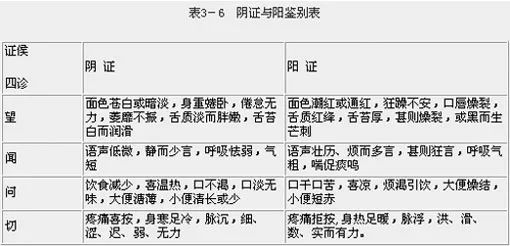
The clinical manifestations of Loss of Yin and Loss of Yang, in addition to the various critical symptoms of the primary disease, often present with varying degrees of sweating. However, the sweating in Loss of Yin is hot and sticky, often accompanied by hot skin, warm hands and feet, thirst with a preference for drinking, and a thin and rapid pulse, indicating a depletion of Yin and an excess of Yang; while the sweating in Loss of Yang is profuse and cool, often accompanied by aversion to cold, lethargy, cold limbs, and a weak pulse, indicating a loss of Yang and an excess of Yin. Since Yin and Yang are interdependent, depletion of Yin fluids leads to the dispersion of Yang Qi, while depletion of Yang Qi leads to the inability of Yin fluids to generate, thus the clinical manifestations of Loss of Yin and Loss of Yang are difficult to separate, and they can rapidly transform into one another, appearing in succession, with only differences in priority and severity.
The treatment for both Loss of Yin and Loss of Yang focuses on supporting the righteous Qi and stabilizing the condition. For Loss of Yin, the approach is to tonify Qi, consolidate Yin, and generate fluids to prevent Loss of Yang, commonly using Sheng Mai San (Generate the Pulse Powder); for Loss of Yang, the approach is to tonify Qi, stabilize the condition, and restore Yang, commonly using Du Shen Tang (Ginseng Decoction) or Shen Fu Tang (Ginseng and Aconite Decoction).
The distinctions among the Eight Principles—Exterior and Interior, Cold and Heat, Deficiency and Excess, Yin and Yang—are not simple, isolated, or static, but rather complex, interconnected, and capable of transformation. In summary, the Eight Principles exhibit relationships of “coexistence,” “mixing,” and “transformation.”
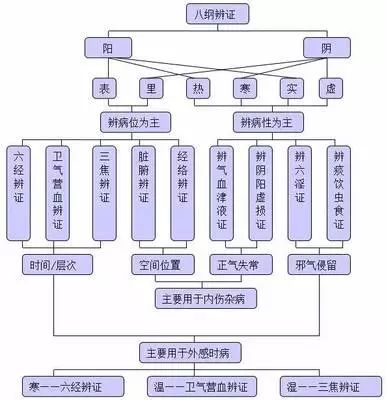
(1) Coexistence
“Coexistence” refers to the simultaneous appearance of symptoms from two or more principles, such as in the early stages of an external heat disease, where both Exterior and Heat symptoms are present, necessitating further differentiation into Exterior Cold or Exterior Heat. In cases of chronic illness, there may be Deficiency syndromes that require further differentiation into Deficiency Cold or Deficiency Heat. The appearance of coexisting symptoms should not be viewed equally, as there is a primary and secondary relationship; for example, both Exterior Cold and Exterior Heat syndromes are primarily classified as Exterior syndromes, with Cold or Heat being secondary. Therefore, treatment should primarily focus on resolving the Exterior, using either warm acrid herbs or cool acrid herbs as appropriate; similarly, both Deficiency Cold and Deficiency Heat syndromes are primarily classified as Deficiency syndromes, with Cold or Heat being secondary, and treatment should primarily focus on tonifying the Deficiency, using either warming or nourishing methods. When Exterior and Interior symptoms coexist, the primary syndrome should be determined based on the specific clinical situation.
(2) Mixing
“Mixing” refers to the simultaneous presence of opposing symptoms from two principles, such as Cold-Heat mixing, Deficiency-Excess mixing, or Exterior-Interior mixing (commonly referred to as simultaneous Exterior and Interior disease). Additionally, during the progression of a disease, false appearances may arise, such as true Heat appearing as false Cold or true Cold appearing as false Heat. Therefore, during the diagnostic process, careful observation and comprehensive analysis are essential to discern the truth and avoid misdiagnosis and mistreatment, which could delay treatment.
(3) Transformation
“Transformation” refers to the phenomenon where symptoms of one principle transform into those of its opposite. The relationships between Exterior and Interior, Cold and Heat, Deficiency and Excess, and Yin and Yang are not only oppositional but can also transform into one another under certain conditions. For example, an external wind-cold condition may present with aversion to cold and fever, headache, etc. If the disease progresses or treatment is inadequate, the pathogenic factors may penetrate into the Interior, leading to a transformation from Exterior Cold syndrome to Interior Heat syndrome; Excess syndromes may transform into Deficiency syndromes due to misdiagnosis or inadequate treatment, where the pathogenic factors gradually diminish but the righteous Qi is also harmed, leading to a gradual transformation into Deficiency syndromes. Conversely, Deficiency syndromes may lead to the generation of phlegm-dampness, Qi stagnation, or blood stasis, resulting in various Excess syndromes. Transformation can only occur under certain conditions, and during the diagnostic process, it is crucial to continuously assess changes in the pathogenesis, make timely diagnoses, and provide treatment to prevent the disease from worsening and to promote recovery.
When applying the Eight Principles of Diagnosis, one should first differentiate between Exterior and Interior to determine the location of the disease; then differentiate between Cold and Heat, Deficiency and Excess, to clarify the nature of the disease and understand the comparative strength of the righteous and pathogenic Qi; finally, one can use Yin and Yang to provide an overarching summary.
Eight Principles of Diagnosis (Mnemonic)
The Eight Principles of Diagnosis serve as a guiding principle for all diseases, each with its own causes, with organ diagnosis as the core, and differentiation of Qi, blood, and body fluids being clear. External heat diseases should be differentiated by layers to assess the type of disease and syndrome.
Exterior Syndrome
Exterior syndrome occurs when the pathogenic factors invade the skin, presenting with symptoms such as nasal congestion, runny nose, headache, fever, aversion to cold, with or without sweating, cough, thin white tongue coating, and floating pulse.
Interior Syndrome
Interior syndrome arises from the transmission of Exterior syndrome or internal generation, with the disease located deeper within the organs, Qi, and blood, encompassing all symptoms that are not classified as Exterior syndrome.
Cold Syndrome
Cold syndrome results from the invasion of Cold pathogenic factors or Yang deficiency, presenting with symptoms such as aversion to cold, preference for warmth, cold limbs, pale complexion, loose stools, and a white, slippery tongue coating.
Heat Syndrome
Heat syndrome results from the invasion of Heat pathogenic factors or Yang excess, presenting with symptoms such as fever, aversion to heat, irritability, thirst with a preference for cold drinks, red face, and a rapid pulse.
Deficiency Syndrome
Deficiency syndrome indicates insufficient righteous Qi, presenting with symptoms such as pale complexion, fatigue, low voice, spontaneous sweating, and a weak pulse.
Excess Syndrome
Excess syndrome indicates an overabundance of pathogenic factors, presenting with symptoms such as flushed face, irritability, high fever, and a strong pulse.
Yang Syndrome
Yang syndrome presents with Heat symptoms, such as fever, aversion to heat, and a rapid pulse, indicating excess Yang Qi.
Yin Syndrome
Yin syndrome presents with Cold symptoms, such as aversion to cold, cold limbs, and a slow pulse, indicating excess Yin.
Presbyopia, blurred vision, and the skill of Gua Sha can help eliminate reading glasses for those with less than 300 degrees of presbyopia.
Original: Gua Sha treatment for rheumatoid arthritis.
Cervical spondylosis is not considered a disease in the face of Gua Sha therapy.

